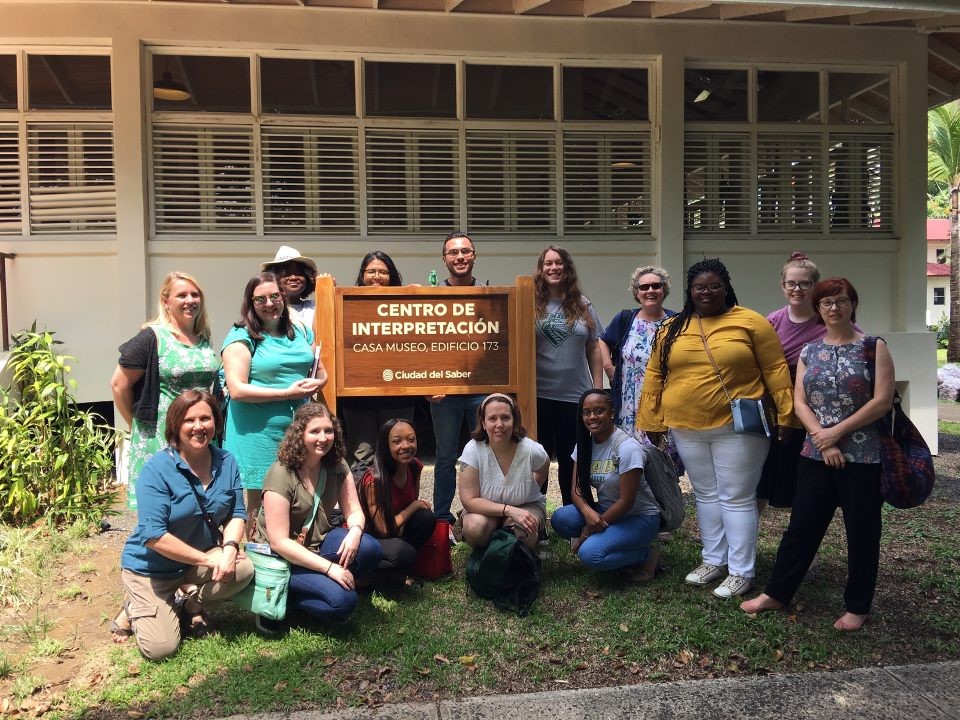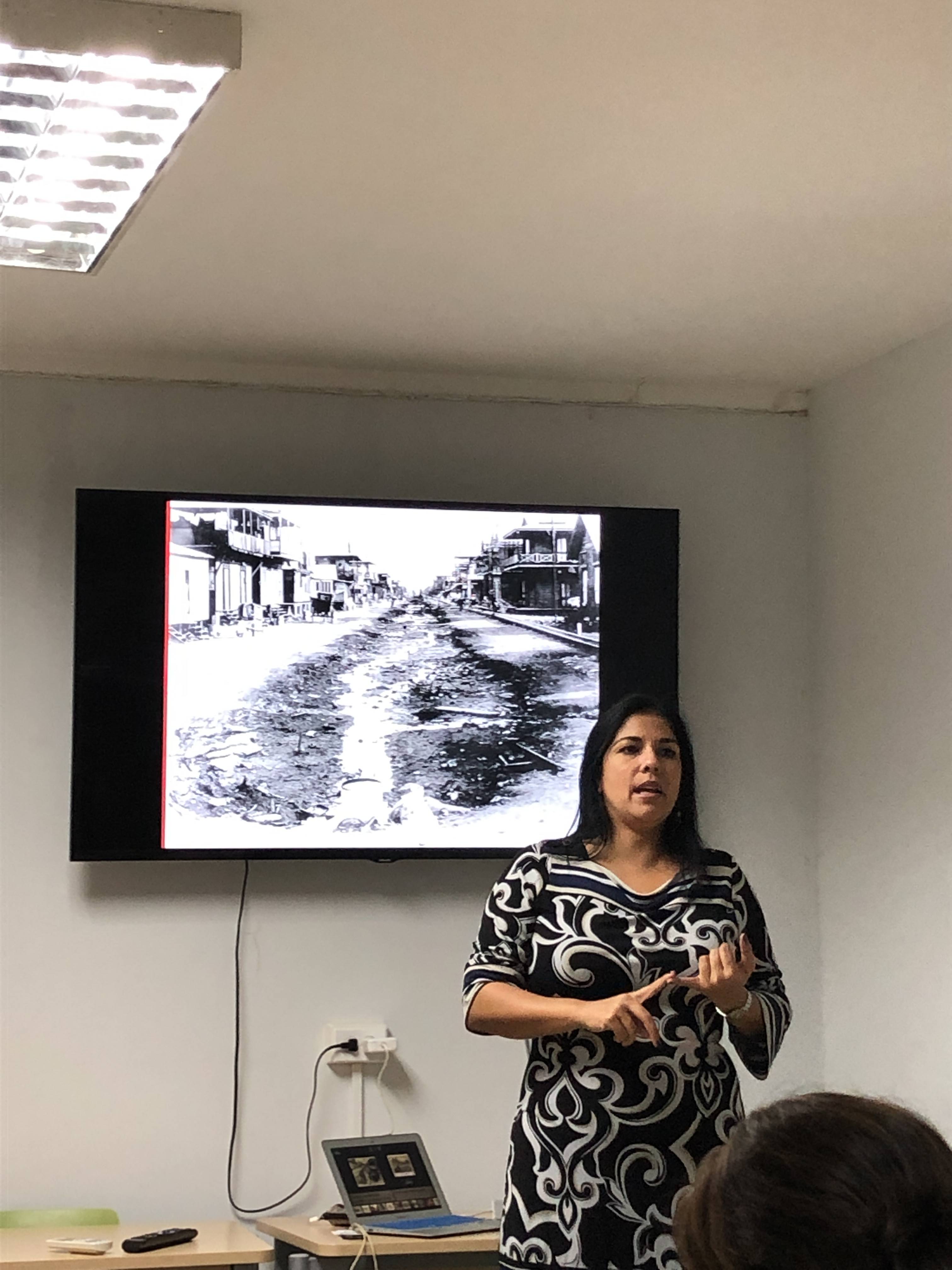
Centro de Interpretación
Ms. Oriana Sanjur greeted us on the masonry steps that led us into the beautifully refurbished Centro de Interpretación at the City of Knowledge (Ciudad de Saber).
The City of Knowledge is located on a former US military base, Fort Clayton, which served as the Southern Command Network headquarters of US Army South.
The History: Ms. Sanjur introduced us to the history of the City of Knowledge and provided a short tour of the museum that honors the history of the site. The former US commander’s home, which houses the center, exemplifies Mission and Art Deco architecture and houses original wicker furniture, a dining suite, and other historical artifacts. The historical artifacts weave the story of Panama, specifically the history of the canal, the US military presence in the country, the political leadership under Omar Torrijos and Manuel Noriega, and the 1977 Carter-Torrijos treaty that would eventually transfer control of the canal back to Panama.
City of Knowledge Today: After discussing the history, Ms. Sanjur talked about the City of Knowledge’s current mission, vision, and goals. Their mission is to encourage innovative social and economic change through programs that support entrepreneurship, education, public health, child protection, cultural development, human rights, and environmental protection. The City of Knowledge contains over 200 buildings which currently house a multitude of non-governmental, non-profit organizations, including the regional offices of the United Nations. Other buildings house private organizations and academic institutions’ satellites including Florida State University and the University of South Florida. The City of Knowledge has an extensive network of collaborators and their efforts are promoting health equity by removing barriers associated with social determinants of health. They have taken existing infrastructure and transformed it into an extensive innovation hub that will work to improve health throughout Central and South America for generations to come.
University of South Florida

History: Later in the day we visited Dr. Arlene Calvo in the University of South Florida Health building located near the front entrance of the City of Knowledge. Dr. Arlene Calvo is a native of Panama who received her MPH and PhD at the University of South Florida. After completing her degrees, she returned to Panama to focus her career on improving health outcomes in her home country. Dr. Calvo’s presentation provided an overview of the history of Panama, the Panama Canal, and US involvement in Panama. She talked about how the history of Panama is shaping some of the issues that Panamanians face today.
The history of the Panama Canal construction was extremely interesting from a public health perspective. We learned that after the French completed the Suez Canal in Egypt they were economically motivated to construct a second canal to connect the Atlantic to the Pacific Ocean. They believed that this would provide a safer and faster route to transport goods and people, eliminating the need to go around Cape Horn. Panama was chosen because of its strategic location and its unique geography given that it is a very narrow landmass and had an abundance of rivers that could be connected to form a canal. Because the Suez Canal was a success, the French believed the technology from that construction would be compatible with construction in Panama, but they were mistaken. Juxtaposed to the geography of Egypt’s arid and fertile land, Panama was wet and marshy, it was impossible for the French to dredge the canal using the same technologies used in Egypt. Another challenge faced was disease, most significantly yellow fever and malaria. Workers died from these diseases at exponential rates. These two factors caused the French project to go bankrupt.

Following the failed attempt to build the canal by France, Panama joined forces with the United States after declaring independence from Columbia in 1903. In return, Panama gave the United States control over the canal to attempt to complete what the French had started. Again, workers began dying of yellow fever and malaria. So, in 1904, after eradicating malaria and yellow fever in Cuba, Dr. William C. Gorgas, an Alabama native, was sent to Panama to attempt the same. Dr. Gorgas asked that they halt construction on the canal for one year to allow him time to establish systems and infrastructure to control the spread of yellow fever and malaria, both of which had been recently identified as vector-borne diseases spread by mosquitos. Dr. Gorgas brought a team of doctors, nurses, and engineers that had worked with him in Cuba and within that one year, they had eliminated cases of yellow fever in the canal zone and controlled malaria. His interventions were instrumental in the construction of the canal and important to this region, perhaps most importantly, he created Panama’s first piped water system and Latin America’s first water treatment plant. These improvements to infrastructure led to significant improvements in health, and marked the beginning of Panama’s current public health programs and institutions.
Public Health Programs: Next, Dr. Calvo presented the structure of Panamanian healthcare and public health systems. She discussed current public health concerns in the country as well as provided an overview of some of her current research initiatives. The programs she mentioned range from addressing teen pregnancy, providing HIV testing and treatment services, and Panama’s vaccine programs. Of note is that Panama, along with El Salvador, are the only two Latin American countries that require the influenza vaccine for all pregnant women. Dr. Calvo spoke about one research project that investigated any possible adverse effects associated with the influenza vaccine in a cohort of 3,500 women. This study was underway during the outbreak of the Zika virus in 2015/2016 and because it was the only ongoing study with a cohort of pregnant women worldwide, study participants were also assessed for Zika. This research provided important insight into the impact of Zika on infants.
Then, Dr. Calvo briefly discussed the causes of mortality and morbidity in Panama. During her discussion we realized that the United States and Panama have similar causes of death including cardiovascular disease, breast and cervical cancers in women, and prostate cancer in men.
We also discussed differences between public health programs in the United States and Panama. Panama has lower smoking rates because they have more aggressive laws which prevent people from smoking in public places and ban the advertising of tobacco products including e-cigarettes. In addition, their anti-tobacco campaigns recruit local artist to design and create graphic murals in popular places around Panama City which depict the dangers of smoking. Many countries could follow Panama’s lead in efforts to reduce the use of tobacco products and thereby reduce tobacco dependency.

Dr. Calvo shared a collaborative health education program that she worked to develop in coordination with the indigenous communities in Panama. They found that while interviewing men from these communities that many openly admitted to spousal abuse. When initially conducting focus groups with tribe members they would specifically ask men if they hit their wife and what they would use to hit their wife. One man, in response to the question, went outside and found a limb and brought it in to show them. So, they took a photo of the limb and are using this image to begin the discussion about domestic violence in health education sessions with indigenous men. This is one example of why it is important to understand cultural values and norms within a community to work to change attitudes and behaviors to improve the public’s health.
In working with indigenous communities, Dr. Calvo also learned that the method of delivery of the health education content is important. Community members requested that the content of their educational program be available and appropriate as technology (computers, projectors, etc) is unavailable in most of their communities. The community expressed that the educational materials needed to be portable, weather resistant (because it often rains in Panama), and comprehensive. So Dr. Calvo’s team produced a laminated flip chart that addressed a multitude of issues from sexual health and domestic violence to chronic disease prevention and nutrition. These materials can be used in any community at any time. This is an example of providing accessible content to address the needs of the community.
Team 1 –
Nekayla Anderson (Public Health Undergrad)
Sloan Oliver (Public Health Undergrad)
Jennifer Schusterman (HCOP/Maternal and Child Health Graduate Student)
